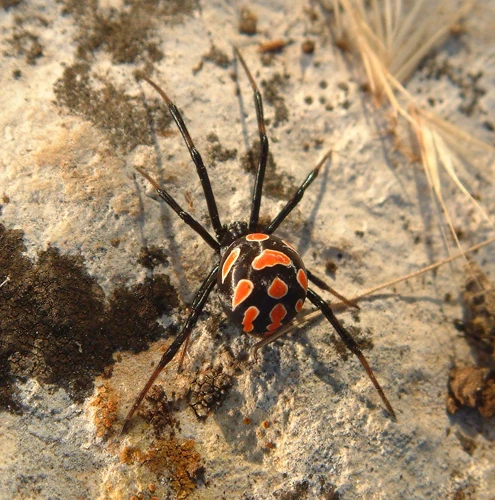As you walk through the woods or tend to your garden, you may come across a spider that sends shivers down your spine. Black widow spiders, known for their venomous bite, are found across the globe, including in Europe. But just how widespread are they? And what habitats do they thrive in? In this article, we delve into the range, habits, and identification of black widow spiders in Europe. Discover everything you need to know about these fascinating yet fearsome eight-legged creatures.
Basic Facts on Black Widow Spiders
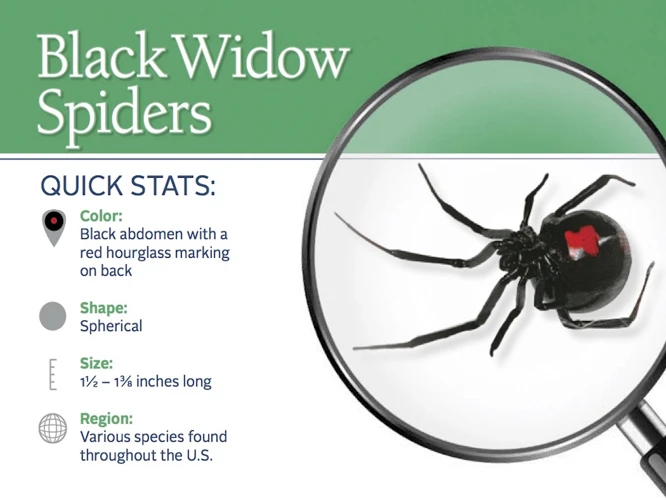
The black widow spider is a well-known arachnid species that belongs to the Latrodectus genus. These spiders are known for their venomous bites, which can be harmful to humans or even lead to fatalities in some cases. They are commonly found in warm and temperate regions all over the world, including Europe. In this section, we’ll explore some basic facts about black widow spiders, including their appearance, behavior, venom, and more. For more information on the black widow’s habitat and distribution, check out our previous section on Black Widow Habitats in Europe.
Appearance and Behavior
Black widow spiders have a distinctive appearance, with the most noticeable feature being their jet-black bodies and bright red hourglass-shaped marking on the abdomen. It is important to note that not all black widow spiders have this marking. Additionally, their bodies are about 1.5 inches long, with males generally being smaller than females. Female black widows are known for their cannibalistic behavior, often consuming their male counterparts after mating.
These spiders are known for their reclusive nature, preferring to hide in crevices, dark corners, and other undisturbed areas. They are most active during the night, and they often spin messy webs to trap their prey. Black widows are known for their venomous bite which they use to subdue their prey.
The behavior of these spiders is affected by the environmental factors of the region where they live. For instance, in rural areas, black widows may thrive in vegetation, barns, and sheds where there is a lot of prey. They will also thrive in suburban areas around residential homes where there are many undisturbed areas, such as woodpiles, leaf litter, and other debris. In contrast to urban and suburban areas, they may struggle to survive in biomes with harsh environmental conditions such as the tundra or high altitude deserts because they cannot withstand the extreme cold.
It is important to note that black widow spiders are not aggressive towards humans. They will only bite when they feel threatened or disturbed. However, their venom is potent and can cause a range of symptoms including severe pain, muscle cramps, and spasms. In rare cases, the bite can be fatal, but this is mainly prevalent in certain geographic regions. To learn more about black widow spider bites, you can refer to /black-widow-spiders-human-envenomation/.
Having knowledge about the appearance and behavior of black widow spiders is essential for recognizing and avoiding them. Their behavior and habitat can be affected by climate change. You can read more about this at /future-black-widow-distribution-climate-change/ and /climate-black-widow-spider/. It is important to take preventive measures to protect yourself from black widow spider bites. You can refer to the upcoming section to learn more about how to prevent black widow spider bites.
Venom and Bite Symptoms
Black Widow Spiders are known for their venomous bite which can have severe effects on humans. The venom is a neurotoxin that can affect the nervous system, and sometimes be life-threatening. The venom of black widow spiders contains high concentrations of the compound α-latrotoxin, which causes intense pain, muscle rigidity, sweating, and tachycardia.
The symptoms can vary in severity depending on the individual’s reaction to the venom. However, it is important to seek medical attention immediately when bitten by a Black Widow Spider. In some cases, the bite can cause death.
Below is a table listing some of the common symptoms associated with Black Widow Spider bites.
| SYMPTOM | DESCRIPTION |
|---|---|
| Intense Pain at Bite Site | Pain at the site of the bite is usually the first symptom experienced by the individual. It can be a sharp or dull pain and can last for several hours. |
| Muscle Cramps and Spasms | Black Widow Spider venom can cause spasms and cramps in the legs, arms, and abdomen. |
| Abdominal Pain and Cramping | Individuals may experience abdominal pain and cramping due to the venom’s effect on the digestive system. This can cause nausea, vomiting, and diarrhea. |
| Elevated Heart Rate and Blood Pressure | The venom of the Black Widow Spider can raise an individual’s heart rate and blood pressure. This can cause anxiety, sweating, and headache. |
| Fever and Chills | Individuals may experience a fever, chills, and sweating as a result of the venom’s effect on the body. |
If someone suspects they have been bitten by a Black Widow Spider, they should seek medical attention immediately. Antivenom may be required depending on the severity of the bite. In some cases, individuals may experience an allergic reaction to the venom, which can be fatal.
It is essential to take precautions when living in areas where Black Widow Spiders thrive. Some tips for preventing Black Widow Spider bites include wearing protective gloves and shoes when working outdoors, shaking out clothing and shoes before putting them on, and keeping outdoor lights turned off to prevent attracting insects, which can attract the spiders.
It is important to understand the potential dangers associated with Black Widow Spider bites. Taking preventative measures and seeking immediate medical attention can minimize the risk of experiencing severe symptoms or complications.
Geographic Distribution of European Black Widow Spiders
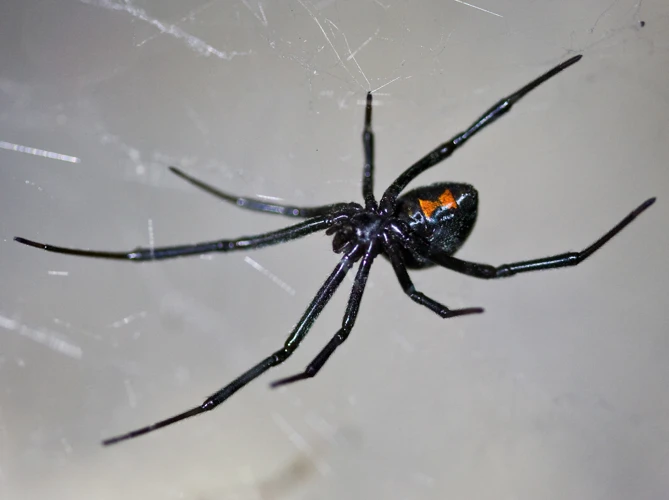
The range of Black Widow spiders in Europe is an important aspect to understand in terms of their prevalence and behavior across the continent. These spiders have a wide distribution in Europe, with some areas being more heavily infested than others. Understanding the geographic distribution of these spiders can help people avoid contact with them and prevent dangerous bites. It is also important to recognize the various habitats in which these spiders thrive and the most common Black Widow species found in Europe. Let’s explore this topic in more detail.
Overview of Their Range
Black widow spiders are not unique to Europe, but they are a notable presence in the continent. These spiders thrive in a variety of environments and can be found in many parts of Europe, from the southern Mediterranean to the northernmost territories. They prefer warmer locations, which makes southern Europe the most hospitable region for them.
The range of black widow spiders in Europe includes a number of countries across the continent, such as:
- Spain
- Portugal
- France
- Italy
- Greece
- Switzerland
- Germany
- Russia
Black widows in Europe, like many other spiders, thrive in a variety of ecosystems, including forests, fields, suburban areas, and urban spaces. Black widow spiders can adapt to different environments, making them a remarkably hardy species.
There are several sub-species that thrive in different regions. For instance, the Mediterranean black widow (Latrodectus tredecimguttatus) prefers the southern regions of Europe, while the Northern black widow (Latrodectus pallidus) is found in the more northerly countries and territories.
The specific habitats black widow spiders prefer vary as well. In general, black widow spiders can be found in warm, dry places with access to plenty of insects for hunting. Their preference for insects can make them a valuable tool for pest control in the areas where they thrive.
Habitats where black widow spiders can be found in Europe include:
- Rocky regions
- Forests
- Fields
- Suburban and urban areas
- Coastal areas
- Wetlands
While black widows in Europe are not the same as their global counterparts, the factors that influence their behavior and survival remain largely the same. Access to food, shelter, and water are critical, and the loss of these resources can have dire consequences for individual spiders and entire communities. Habitat destruction, in particular, is a major reason black widow populations have declined in other parts of the world.
To learn more about the black widow species found in Europe, continue reading the next section where we discuss the most common black widow species found in the continent. You can also learn how to identify this spider species and prevent black widow spider bites.
Black Widow Habitats in Europe
Black Widow spiders in Europe are commonly found in diverse habitats. These spiders like to live in dry, dark, and sheltered areas where they can easily catch their prey. With that being said, Black Widows can be found pet in urban, suburban, and rural areas as well as in forests and other biomes. They build their webs in secluded areas such as rock crevices, bushes, and tree trunks.
It is important to note that the three most common Black Widow species found in Europe have different preferences for their habitat. The Latrodectus mactans tends to thrive in rural areas with a warm and dry climate. Meanwhile, the Latrodectus tredecimguttatus can be found mainly in suburban areas where they prefer to stay closer to human settlements. The Latrodectus hesperus and Latrodectus geometricus, two species that are not native to Europe but have been introduced to the continent, can be found in both urban and suburban areas.
However, Black Widow habitat destruction has become a major concern in Europe. The rapid expansion of urban areas and agricultural activities have led to the destruction of natural habitats. This causes these spiders to increasingly invade human settlements as a result of habitat loss. It is important for people to protect the environment by promoting sustainable land-use practices and conserving natural habitats where Black Widow spiders can thrive.
Black Widow spiders in Europe are naturally found in different types of habitats, from urban areas to forests. Knowing their preferred habitat is important for identifying their potential presence in an area. Nonetheless, it is important to be mindful of their habitat destruction and work towards conservation efforts to prevent the loss of their natural habitats.
Most Common Black Widow Species in Europe
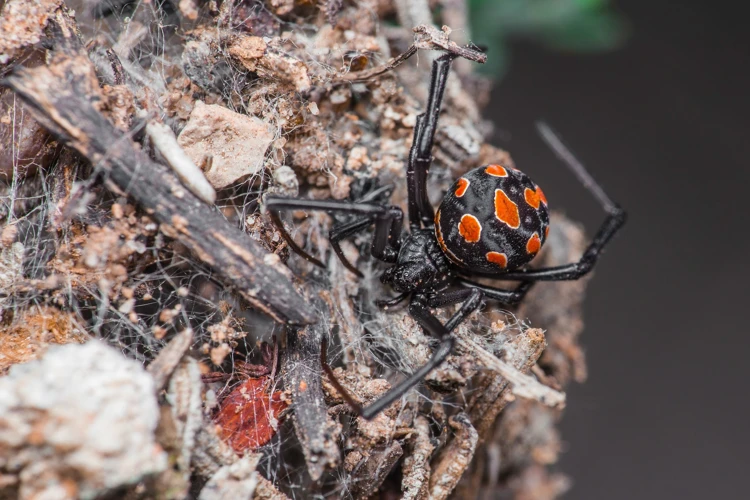
As one of the most venomous spiders in Europe, black widows can be found in various regions and habitats across the continent. Knowing the most common species of black widow spiders in Europe is essential in identifying potential threats to your safety. These species include the L. tredecimguttatus, L. mactans, and L. hesperus and L. geometricus. While they thrive in different environments and have distinct appearance and behavior, one should remain cautious of all potential encounters with black widows. As human activity continues to encroach on their natural habitats, black widow spiders are adapting to new environments, which may increase their chances of interacting with people. Let’s explore the most common black widow species in Europe and learn how to identify them.
L. tredecimguttatus
L. tredecimguttatus, commonly referred to as the Mediterranean Black Widow, is a venomous spider species found in various parts of Europe. These spiders are known to prefer arid and semi-arid habitats, such as rocky areas near the sea, scrublands, and vineyards. They can also be found in urban and suburban areas, hiding in dark and sheltered places like sheds, garages, and basements.
The Mediterranean Black Widow grows up to 15mm in length and can be identified by a pattern of 13 red or white spots on its jet-black abdomen. The spots are arranged in a semi-circle that is wider at one end than the other, resembling an hourglass. Females are larger and have a more conspicuous pattern than males.
L. tredecimguttatus spiders are aggressive and can deliver a painful bite when threatened. Their venom contains neurotoxins that affect the central nervous system. Symptoms of a black widow bite include intense pain at the site of the bite, muscle cramps, spasms, sweating, nausea, and vomiting. In severe cases, the symptoms can spread to the chest, abdomen, and back, leading to breathing difficulties and even death.
To avoid encountering L. tredecimguttatus spiders, it is important to take precautionary measures like wearing gloves and long sleeves when working in areas where they might be present. Inspect dark and secluded areas in your home and garden where these spiders might take shelter and remove any potential hiding places.
It is alarming to note that human activities like habitat destruction and climate change are threatening the survival of black widow spiders, including L. tredecimguttatus. The destruction of natural habitats can lead to the displacement of spiders, while changes in temperatures and rainfall patterns can disrupt their feeding and breeding habits. These factors can have a detrimental effect on the black widow population in Europe.
If you want to learn more about other black widow species that are found in Europe or around the world, check out our articles on /global-black-widow-spiders/ and /rural-black-widows/. You can also find out about the biomes where black widow spiders thrive on our page, /biomes-black-widow-spider-thrive/. Additionally, if you want to know more about the fatal effects of black widow spider bites around the world, read our article on /black-widow-bite-fatalities-geo/.
L. mactans
L. mactans, also known as the Mediterranean black widow, is another commonly found species in Europe. They are typically found in southern Europe, specifically in countries like Italy, Greece, Spain, and Portugal. Similar to L. tredecimguttatus, they prefer warmer climates and often inhabit vegetation like bushes, shrubs, and vines.
The female L. mactans is recognized by its shiny black body with a distinctive hourglass-shaped red or orange marking on the underside of its abdomen. The male, on the other hand, is much smaller in size and has a mottled brown coloration.
While their venom is reportedly less potent compared to other black widow species, L. mactans can still deliver a painful bite that may cause serious symptoms. In fact, their venom contains powerful neurotoxins that can cause muscle spasms, abdominal pain, and even paralysis.
To avoid the risk of encountering L. mactans, it’s important to take necessary precautions when venturing outdoors, especially in wooded areas, gardens, and parks. Wearing long-sleeved shirts and pants can provide some protection against spider bites. If you suspect that you may have been bitten by a black widow spider, seek immediate medical attention to avoid potential complications.
The destruction of black widow habitats, such as through urbanization and deforestation, can have a significant impact on the populations of L. mactans and other black widow species throughout Europe. Actions such as the use of pesticides and development projects that lead to habitat destruction can ultimately harm these spider populations and their ecosystems. It’s important to take steps to protect black widow habitats to maintain the biodiversity of these regions.
The suburban black widow spider, a common species found in urban and suburban regions of Europe, can also pose a threat to humans. Check out our article on suburban black widow spiders to find out more about their habitat and distribution.
L. hesperus and L. geometricus
Two of the common black widow spider species found in Europe are L. hesperus and L. geometricus. While these two species are native to different regions, they have both been introduced to Europe, likely through the transportation of goods.
L. hesperus, also known as the Western black widow, is native to North America but has spread to other parts of the world, including Europe. This species is easily identified by the bright red hourglass marking on its abdomen. The rest of the body is typically black or dark brown. L. hesperus is commonly found in the Mediterranean region of Europe.
L. geometricus, also known as the brown widow, is native to Africa but has also been introduced to Europe and other regions. This species is smaller than the other black widow species found in Europe, with a body length of around 10 mm. It is identified by the orange or yellow hourglass shape on its back and additional markings on its body that form a geometric pattern. L. geometricus is commonly found in Southern Europe.
It is important to note that these two black widow species have different habits and habitats. While L. hesperus is commonly found in outdoor habitats such as woodlands and deserts, L. geometricus is frequently found in indoor habitats such as sheds and garages.
Despite the differences in habitat preference, both L. hesperus and L. geometricus are dangerous and their bites can cause serious symptoms. It is important to take measures to prevent contact with these spiders and seek medical attention if bitten.
Unfortunately, the destruction of black widow spider habitats is becoming more and more common. This has led to a decrease in their numbers and potential extinction in the future. To learn more about the effects of habitat destruction on black widow spiders, check out our article on black widow habitat destruction.
How to Identify Black Widow Spiders in Europe
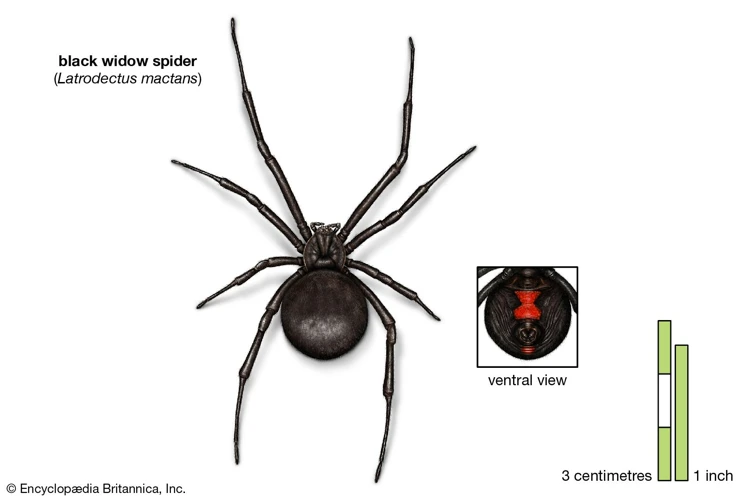
Identification of black widow spiders can be quite challenging, but there are certain key features that can help you to distinguish them from other spider species. The easiest way to identify a black widow spider is by its shiny and smooth black body shape with a characteristic red hourglass-shaped mark on its belly. This is the most distinctive feature of the black widow and serves as a warning to potential predators from a distance.
The female black widow spider has a larger and more robust body size than the males, which are generally much smaller and lighter in color. The males may have a more colorful and intricate pattern on their abdomen.
Another useful clue to identify black widow spiders is their web. Unlike most spider species that have a randomly structured web, black widow spiders build a specific and organized web pattern. Their webs are tangled and sticky, have a concave shape, and point downward from the spider’s hiding place.
It’s worth noting that there are several other spider species that resemble black widow spiders and can be easily mistaken for them. These species include false black widow spiders, which lack the red hourglass mark and have a larger, more bulbous abdomen.
If you come across a spider that you think may be a black widow, it’s essential to handle it with care and avoid any direct contact. Black widow spiders are highly venomous and can cause severe health effects if bitten.
If you’re unsure about the identification of a spider and need confirmation, you can consult an online resource or seek expert advice from a local pest control service. Remember that to prevent black widow spider bites, it’s necessary to identify and avoid contact with them as much as possible.
Preventing Black Widow Spider Bites
When it comes to protecting ourselves from black widow spider bites, prevention is key. These spiders are known for their venomous bites, which can cause a variety of unpleasant symptoms. However, by taking some simple precautions, we can minimize the risk of encountering these spiders and prevent any potential bites. In this section, we’ll go over some of the most effective ways to prevent black widow spider bites and keep these spiders at bay. Whether you’re spending time outdoors or just want to make your home less hospitable to spiders, these tips are sure to come in handy. So, let’s dive into the world of black widow spider prevention and learn how to stay safe.
Avoiding Contact with Spiders
To avoid contact with black widow spiders, it is important to take certain precautions, especially when in areas where they are commonly found. Here are some ways to stay safe and avoid bites:
- Be cautious when entering areas where spiders may be present, such as barns, garages, sheds, or wood piles. Use a flashlight to inspect the area before entering and wear protection such as gloves and long sleeves.
- Avoid sitting or reaching under rocks, logs, or other objects where spiders may be hiding.
- Keep all areas, particularly those where food is stored or prepared, clean and free of clutter as this can attract insects, which in turn attract spiders.
- When camping, make sure to shake out clothing and bedding before use to remove any potential spiders or insects.
- If you find a spider in your home, do not try to handle or capture it. Instead, use a vacuum cleaner to remove it or contact pest control for assistance.
Remember, if you do get bitten by a black widow spider, seek medical attention immediately. Symptoms can be severe and even life-threatening if left untreated. By taking preventative measures, you can minimize the risk of encountering these spiders and reduce the chance of bites occurring.
Protecting Your Home and Garden
Keeping black widow spiders out of your home and garden is essential to preventing bites. This can be achieved through several measures, such as sealing up cracks and holes in your home, using insecticides, and keeping a tidy garden.
One way to keep black widow spiders out of your home is to seal up any cracks or holes. Use caulk to fill in gaps around windows and doors and place weatherstripping around entry points. You can also install screens on windows and doors to keep spiders from entering your home.
Using insecticides is another effective way to prevent black widow spiders from entering your home. Use a residual insecticide around the perimeter of your home, paying attention to areas where spiders are likely to enter. You can also use insecticide sprays indoors, focusing on areas where spiders may hide.
In addition to protecting the inside of your home, it’s important to keep your outdoor space tidy. Black widow spiders are attracted to cluttered areas, so make sure to keep your garden well-maintained. Keep vegetation trimmed and remove any debris or woodpiles where spiders might hide.
Here are some additional tips for protecting your home and garden:
| Tip | Description |
| Store firewood away from your home | Black widow spiders can hide in firewood, so keep it at least 20 feet away from your home. |
| Wear gloves when gardening | Since black widow spiders can hide in plants, it’s important to wear gloves to avoid bites when working in your garden. |
| Use sticky traps | Sticky traps are a non-toxic way to catch black widow spiders. Place them in areas where spiders are likely to hide, such as dark corners and under furniture. |
| Remove spider webs | Regularly clean and remove spider webs from your home and outdoor spaces using a vacuum or broom. |
By following these tips, you can reduce the risk of black widow spider bites and keep your home and garden spider-free.
Conclusion
After covering the range of black widow spiders in Europe and their habits, it is clear that these spiders are a force to be reckoned with. While they may be fearsome, it is important to remember that they play an important role in their ecosystems, helping to control insect populations and maintain a balance.
When it comes to encountering black widows, it is important to exercise caution and take the necessary steps to protect yourself and your surroundings. This includes avoiding contact with the spiders whenever possible, as well as taking steps to remove potential habitats and food sources from your home and garden.
Despite their reputation as dangerous spiders, black widows are fascinating creatures that are worthy of study and respect. If you find yourself in an area where black widows are known to reside, it is important to approach them with care and take the necessary precautions to prevent bites and other issues.
In conclusion, the range of black widow spiders in Europe is vast, and they can be found in a variety of habitats across the continent. While they may seem scary, it is important to remember that they play an important role in their ecosystems and should be treated with respect and caution. By taking the necessary precautions and educating ourselves about their habits and behaviors, we can coexist with these amazing creatures in a safe and responsible manner.
Frequently Asked Questions
What are the basic facts on black widow spiders?
Black widow spiders are venomous and belong to the Latrodectus genus. They are mostly known for the red hourglass marking on their abdomen.
What do black widow spiders look like?
Black widow spiders are black or dark brown in color and have a shiny, globular abdomen. Females usually have a red hourglass marking on their abdomen, while males may have red or yellow spots on their backs.
Where are black widow spiders found?
Black widow spiders are found on all continents except for Antarctica. They prefer warm, dry climates and can be found in a variety of habitats, including forests, deserts, and urban areas.
What is the geographic distribution of black widow spiders in Europe?
Black widow spiders are found primarily in southern Europe, including Spain, Italy, Greece, and Cyprus. They can also be found in some parts of France, Portugal, and Turkey.
What are the most common black widow species in Europe?
The most common black widow species in Europe are Latrodectus tredecimguttatus and Latrodectus mactans.
How do you identify a black widow spider in Europe?
You can identify a black widow spider by their shiny, globular abdomen and red hourglass marking (on females) or red/yellow spots (on males).
What should I do if I am bitten by a black widow spider?
If you are bitten by a black widow spider, seek medical help immediately. They may prescribe antivenom or pain relievers to help with symptoms.
How can I prevent black widow spider bites?
To prevent black widow spider bites, avoid contact with spiders by wearing gloves and long sleeves while gardening or cleaning. You can also use insect repellent and keep your home and garden tidy to reduce the likelihood of spider encounters.
Are black widow spiders dangerous?
Black widow spider bites can be dangerous, but fatalities are rare. Symptoms include muscle pain, cramps, and spasms, which can be severe in young children and older adults.
What is the lifespan of a black widow spider?
Female black widow spiders can live up to three years, while males usually live for only a few months.

